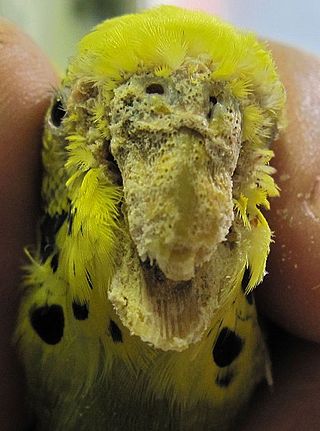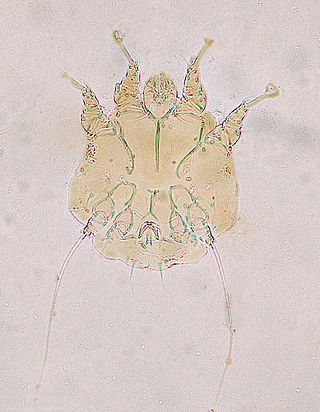Mange is a skin disease.
Mange may also refer to:
- several other skin diseases like demodectic mange, psoroptic mange, or notoedric mange
- Mange Temple, in China
Mange is a skin disease.
Mange may also refer to:

Scabies is a contagious human skin infestation by the tiny (0.2–0.45 mm) mite Sarcoptes scabiei, variety hominis. The word is from Latin: scabere, lit. 'to scratch'. The most common symptoms are severe itchiness and a pimple-like rash. Occasionally, tiny burrows may appear on the skin. In a first-ever infection, the infected person usually develops symptoms within two to six weeks. During a second infection, symptoms may begin within 24 hours. These symptoms can be present across most of the body or just certain areas such as the wrists, between fingers, or along the waistline. The head may be affected, but this is typically only in young children. The itch is often worse at night. Scratching may cause skin breakdown and an additional bacterial infection in the skin.
Plaque may refer to:

Sarcoptes scabiei or the itch mite is a parasitic mite found in all parts of the world that burrows into skin and causes scabies. Humans become infested by Sarcoptes scabiei var. hominis; other mammals can be infested with different varieties of the mite. They include wild and domesticated dogs and cats, ungulates, wild boars, bovids, wombats, koalas, and great apes.

Mange is a type of skin disease caused by parasitic mites. Because various species of mites also infect plants, birds and reptiles, the term "mange", or colloquially "the mange", suggesting poor condition of the skin and fur due to the infection, is sometimes reserved for pathological mite-infestation of nonhuman mammals. Thus, mange includes mite-associated skin disease in domestic mammals, in livestock, and in wild mammals. Severe mange caused by mites has been observed in wild bears. Since mites belong to the arachnid subclass Acari, another term for mite infestation is acariasis.

Demodicosis, also called Demodex folliculitis in humans and demodectic mange or red mange in animals, is caused by a sensitivity to and overpopulation of Demodex spp. as the host's immune system is unable to keep the mites under control.
Scab may refer to:
Exfoliation can refer to:
Skin disorders are among the most common health problems in dogs, and have many causes. The condition of a dog's skin and coat is also an important indicator of its general health. Skin disorders of dogs vary from acute, self-limiting problems to chronic or long-lasting problems requiring life-time treatment. Skin disorders may be primary or secondary in nature, making diagnosis complicated.

Mud fever, also known as scratches or pastern dermatitis, is a group of diseases of horses causing irritation and dermatitis in the lower limbs of horses. Often caused by a mixture of bacteria, typically Dermatophilus congolensis and Staphylococcus spp., mud fever can also be caused by fungal organisms (dermatophytes). Photosensitization, chorioptic mange mites, contact dermatitis, and other conditions also contribute to some cases. This condition is also known as dew poisoning, grease, grease heel, or greasy heel.
St. Anthony's fire may refer to:

Chronic progressive lymphedema (CPL) is a disease of some breeds of draft horse, whereby the lower legs becomes progressively more swollen. There is no cure; the aim of treatment is to manage the signs and slow progression of the disease. The cause of CPL is not known, although it is suspected that a genetic disorder of elastin metabolism prevents the lymphatic vessels from functioning properly, leading to edema of the lower limbs. CPL resembles the human disease elephantiasis verrucosa nostra.
Cat skin disorders are among the most common health problems in cats. Skin disorders in cats have many causes, and many of the common skin disorders that afflict people have a counterpart in cats. The condition of a cat's skin and coat can also be an important indicator of its general health. Skin disorders of cats vary from acute, self-limiting problems to chronic or long-lasting problems requiring life-time treatment. Cat skin disorders may be grouped into categories according to the causes.
Mangy may mean:
Struma may refer to:

Feline acne is a problem seen in cats primarily involving the formation of blackheads accompanied by inflammation on the cat's chin and surrounding areas that can cause lesions, alopecia, and crusty sores. In many cases, symptoms are mild and the disease does not require treatment. Mild cases will resemble dirt on the cat's chin, but the "dirt" will not be brushed off. More severe cases, however, may respond slowly to treatment and seriously detract from the health and appearance of the cat. Feline acne can affect cats of any age, sex, or breed, although Persian cats are also likely to develop acne on the face and in the skin folds. This problem can happen once, reoccur, or even persistent throughout the cat's life.
Pinta may refer to:
Mangal is an Asian given name and surname.

Scaly foot, or knemidocoptiasis is a bird ailment that is common among caged birds and also affects many other bird species. It is caused by mites in the genus Knemidokoptes which burrow into the bird's flesh. The tunnels made by the mites within the skin cause dermatitis and scaly lesions. Scaly face is caused by the same mite responsible for scaly foot and other related mites cause depluming. The condition is transmitted from one bird to another by direct prolonged contact.
Vulgaris, a Latin adjective meaning common, or something that is derived from the masses of common people, may refer to:

Notoedric mange, also referred to as Feline scabies, is a highly contagious skin infestation caused by an ectoparasitic and skin burrowing mite Notoedres cati. N. cati is primarily a parasite of felids, but it can also infest rodents, lagomorphs, and occasionally also dogs and foxes. This skin disease also has zoonotic potential. Infestation is also called acariasis, which refers to a rash that is caused by mites.